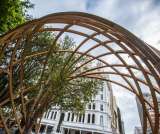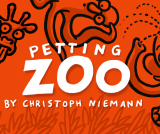First Published in
Our aim is to grow the South African creative industries by showing internationals with creative clout that we have what they want in the backyard and we also want to create discerning consumers.
Among our inspiration is the so-called rise of the creative class – according to Professor Richard Florida, who penned a book on the subject, the most influential people in society today are those people making their living being creative. We asked some of the Expo advisory panel members, who have the enviable task of perusing a large amount of beautiful work in order to draw up the exhibitor list, about this upsurge in interest in all things creative.
Another theme is homegrown and we’ve found out what this looks like by getting a bit of product from the local industry. As we’re putting the designer/creator upfront at this Expo, we’ve asked them to step up and talk about the homegrown in their work. We also loped around getting the lowdown on local on the street.
Ross Chowles, Jupiter Drawing Room
As a South African, I'm well aware that we may never compete globally in manufacturing efficiencies. So what will make us competitive is our creativity. South Africa is the collision of cultures, the tension between the past and the future. This creates an environment of energy, the perfect energy for creative thinking. It excites me that we are at a point where the establishment don't see creatives as bohemian arty types living in the forest but rather as innovative thinkers who can save business.
Maxine Leyschon, Jeremy Stewart and Andrew Merrington, Source
Finally, South Africans are realising the massive groundswell of creative talent and inspiration that is right here on our doorstep. If the potential of the new class of creatives is realised, the commercial and socio-economic opportunities for our country are endless. Design and creativity should be seen as one of our natural resources alongside gold, diamonds and platinum.
Being able to contribute to this uprising is hugely exciting for us. Gone are the days of looking to international sources for inspiration. South African designers can hold their heads up high as the excellent levels of design, inspired by our country, are realised in our country.
Luyanda Mphalwa, MMA Architects
Society can best express itself and its values through the existence of creative and innovative minds. Such creativity usually flourishes and excels where there is a deep and fundamental understanding of the influences from which designers draw their inspiration. This is true for most of the creative arts and industries, which are always in search of that cutting edge innovation that will set the individual creator/artist/designer apart from the rest. Design in the commercial world is particularly always faced with constant changes influenced by trends and tastes driven by competition for greater market share.
Design, however, cannot and should not be reduced purely to aesthetic considerations only.
Creative disciplines like fashion design, music, the performing arts, artists, interior design, publishers etc…are also faced with the challenge of withstanding global creative influences and pressures, which makes it even more difficult to achieve that creative and innovative edge in the marketplace. South African designers, who without doubt are significant players in the world stage, are faced with the challenge of pushing the boundaries of design and creativity further, if they are to achieve and maintain the creative edge. In my opinion, competition driven by the quest for design excellence should be the determining factor.
Successful design is solution driven, and often requires creativity to solve various complex issues and to satisfy societal needs. The “rise of the creative class” therefore, is inextricably linked with the need to articulate and satisfy a variety of social, cultural and economic needs.
Architectural design
I have deliberately excluded architecture, which is my subject area of design activity, from the above reflection on creative disciplines. The one reason is that Architecture can be seen as the “mother of all Arts”, requiring architects to provide creative solutions to all manner of complex issues. The creation of buildings is a lengthy process, which also requires architects to possess all the human senses and interpret them in the context of space-making.
The other reason is that in my view, while there is outstanding architecture emerging from South Africa, a tension exists between the interpretation of architectural identity from a local and an international perspective. Some architects tend to argue that architectural design is a universal creative design and should not necessarily express any particular value system, let alone locally relevant cultural and traditional references.
In my opinion, there’s an urgent need for architects to engage in debates about how the rich cultures and social values characteristic of this continent and its people can be expressed through architecture. Currently, such debates are isolated and do not yet express a particular direction in the development of architecture in this country. It is evident through most major projects that have been built in the recent period that the issue of architectural identity is being avoided, or is exaggerated in some cases.
An architectural creative class?
In order for a architectural creative class to develop and become a significant player in the projected decades of designers, architects have to apply the universal design principles to articulate and express the best which the locally relevant cultures, materials, building traditions and techniques have to offer. Only in this way shall we achieve and maintain a competitive edge, drawing our inspiration from resources that do not exist anywhere else in the world. The diversity of South Africa is the strength and inspiration from which the creative class should draw in my view. I also believe that other creative disciplines and arts have advanced much further than architecture in this regard, without necessarily being ethnic or vernacular. There is a need to explore an african-inspired design approach and aesthetic which exists and is sophisticated, elegant and internationally competitive.
Please show us your stuff and tell us why it represents the homegrown?
Barbara Jackson, Monkeybiz
Our product reflects the spirit of the women who make them – optimistic, enthusiastic and filled with love. They’re also contemporary, sophisticated interpretations of traditional design.
Dagmar Moko, Moko Floral Design
This bag is literally homegrown as it’s made from proteas grown in the Cape. I love working with indigenous flowers in an original and conceptual way.
Maira Koutsoudakis, Life
When designing I look for that intangible place where intelligence and intuition merge, and a new signature style emerges. Homegrown design is: + a celebration of our cultural diversity and the conscious creative awareness of our unique South African points of differentiation + a contemporary rendition of traditional (South) African design - culture, texture, craft, quirk - reinterpreted in an essay of respect and irreverence + a fearlessly post-modern perspective which celebrates the concept above the product - a sense rather than a thing. + when you can almost taste how right, right now, right here, a product is
Gregory Katz, SITU Lucite Diamond Jewellery
Few designers have had the opportunity to experiment with new ways of setting and wearing diamonds. Diamonds are indigenous to South Africa and all the pieces are handcrafted in South Africa.
The combination of local design talent like Philippa Green and Ida Elsje, local materials and a spirit of experimentation has yielded an original and innovative range of jewellery that combines diamonds, Lucite and fine metals.
Garth Walker, Orange Juice Design
I was recently asked to design a self-portrait for a poster exhibition in Tehran, Iran. The organisers asked 20 designers from 20 countries to design and print a self-portrait poster. I’m still trying to find an international courier company to deliver my printed poster – needless to say Mr Bush and his war hasn’t helped! I’m not really a poster designer (South Africa does not have a poster culture - a legacy from the apartheid mindset), so this was an interesting exercise for me.
As it's a self-portrait, I wanted to use images that had meaning for me, and were connected to me personally (as something I related to or had actually produced). I’ve always liked the 'sheep heads' – from a piece I did for i-Jusi issue 14.
I found and photographed these heads in Durban's fresh produce market. They’re a metaphor for my own face, as is the black sheep/white sheep/black/white never-ending story blah, blah. I’m white, but tend to prefer 'black culture' in my work so I think they’re appropriate. The addition of graphic marks and other devices are there simply because I liked them. I design a lot with stuff "I just like". The title 'Fuck Africa' refers to how many people on my travels round the world see us. I think we’re 'fucked', but that's exactly why I love Africa...
Philip Loxton, Mila Company
They were conceptualised in Observatory in Cape Town!
Kelly Bloom, Bloom Handbags
This bag is the perfect combination of ethnic (springbok hair) and modern (steel ring handle). This is how I perceive the direction of the South African design environment, and I think the international design community will follow suit.


























